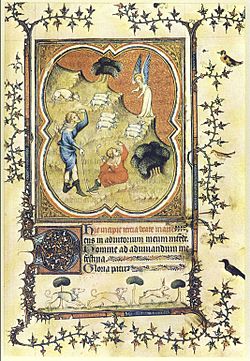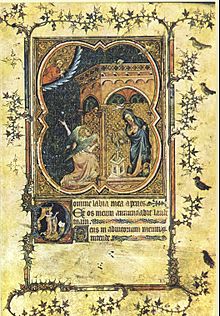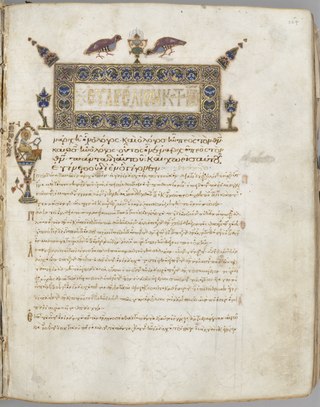
An illuminated manuscript is a formally prepared document where the text is decorated with flourishes such as borders and miniature illustrations. Illuminated manuscripts include liturgical books such as psalters, courtly literature, and documents such as proclamations.

International Gothic is a period of Gothic art which began in Burgundy, France, and northern Italy in the late 14th and early 15th century. It then spread very widely across Western Europe, hence the name for the period, which was introduced by the French art historian Louis Courajod at the end of the 19th century.

The Limbourg brothers were Dutch miniature painters from the city of Nijmegen. They were active in the early 15th century in France and Burgundy, working in the International Gothic style.

Books of hours are Christian prayer books, which were used to pray the canonical hours. The use of a book of hours was especially popular in the Middle Ages, and as a result, they are the most common type of surviving medieval illuminated manuscript. Like every manuscript, each manuscript book of hours is unique in one way or another, but most contain a similar collection of texts, prayers and psalms, often with appropriate decorations, for Christian devotion. Illumination or decoration is minimal in many examples, often restricted to decorated capital letters at the start of psalms and other prayers, but books made for wealthy patrons may be extremely lavish, with full-page miniatures. These illustrations would combine picturesque scenes of country life with sacred images.
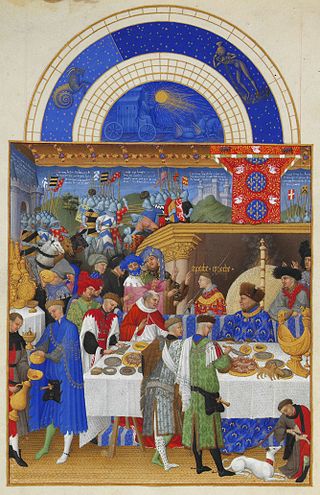
The Très Riches Heures du Duc de Berry, or Très Riches Heures, is the most famous and possibly the best surviving example of manuscript illumination in the late phase of the International Gothic style. It is a book of hours: a collection of prayers to be said at the canonical hours. It was created between c. 1412 and 1416 for the extravagant royal bibliophile and patron John, Duke of Berry, by the Limbourg brothers. When the three painters and their sponsor died in 1416, possibly victims of plague, the manuscript was left unfinished. It was further embellished in the 1440s by an anonymous painter, who many art historians believe was Barthélemy d'Eyck. In 1485–1489, it was brought to its present state by the painter Jean Colombe on behalf of the Duke of Savoy. Acquired by the Duc d'Aumale in 1856, the book is now MS 65 in the Musée Condé, Chantilly, France.

Simon Marmion was a French and Burgundian Early Netherlandish painter of panels and illuminated manuscripts. Marmion lived and worked in what is now France but for most of his lifetime was part of the Duchy of Burgundy in the Southern Netherlands.

Barthélemy d'Eyck, van Eyck or d' Eyck, was an Early Netherlandish artist who worked in France and probably in Burgundy as a painter and manuscript illuminator. He was active between about 1440 to about 1469. Although no surviving works can be certainly documented as his, he was praised by contemporary authors as a leading artist of the day, and a number of important works are generally accepted as his. In particular, Barthélemy has been accepted by most experts as the artists formerly known as the Master of the Aix Annunciation for paintings, and the Master of René of Anjou for illuminated manuscripts. He is thought by many to be the Master of the Shadows responsible for parts of the calendar of the Très Riches Heures du Duc de Berry.

The Hours of Catherine of Cleves is an ornately illuminated manuscript in the Gothic art style, produced in about 1440 by the anonymous Dutch artist known as the Master of Catherine of Cleves. It is one of the most lavishly illuminated manuscripts to survive from the 15th century and has been described as one of the masterpieces of Northern European illumination. This book of hours contains the usual offices, prayers and litanies in Latin, along with supplemental texts, decorated with 157 colorful and gilded illuminations. Today, both parts of the manuscript that forms this book are housed at the Morgan Library and Museum in New York City.
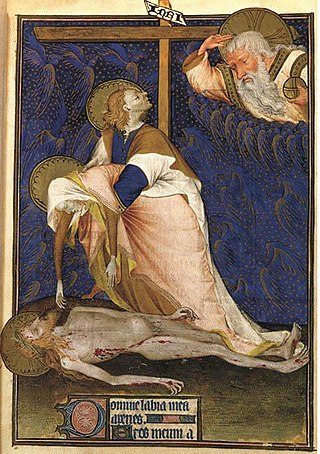
The Grandes Heures de Rohan is an illuminated manuscript book of hours, painted by the anonymous artist known as the Rohan Master, probably between 1418 and 1425, in the Gothic style. It contains the usual offices, prayers and litanies in Latin, along with supplemental texts, decorated with 11 full page, 54 half page, and 227 small miniatures, decorated with tempera paints and gold leaf. The book margins are decorated with Old Testament miniatures with captions in Old French, in the style of a Bible moralisée. The full page illuminations are renowned for the highly emotional and dramatic portrayal of the agonies of Christ and the grief of the Virgin. According to Millard Meiss, "The Rohan Master cared less about what people do than what they feel. Whereas his great predecessors excelled in the description of the novel aspects of the natural world, he explored the realm of human feeling." Meiss concludes that the Rohan Master was the "greatest expressionist in 15th century France." The manuscript is currently housed in the Bibliothèque Nationale, Paris, France.

Jean Miélot, also Jehan, was an author, translator, manuscript illuminator, scribe and priest, who served as secretary to Philip the Good, Duke of Burgundy from 1449 to Philip's death in 1467, and then to his son Charles the Bold. He also served as chaplain to Louis of Luxembourg, Count of St. Pol from 1468, after Philip's death. He was mainly employed in the production of de luxe illuminated manuscripts for Philip's library. He translated many works, both religious and secular, from Latin or Italian into French, as well as writing or compiling books himself, and composing verse. Between his own writings and his translations he produced some twenty-two works whilst working for Philip, which were widely disseminated, many being given printed editions in the years after his death, and influenced the development of French prose style.

The Turin–Milan Hours is a partially destroyed illuminated manuscript, which despite its name is not strictly a book of hours. It is of exceptional quality and importance, with a very complicated history both during and after its production. It contains several miniatures of about 1420 attributed to an artist known as "Hand G" who was probably either Jan van Eyck, his brother Hubert van Eyck, or an artist very closely associated with them. About a decade or so later Barthélemy d'Eyck may have worked on some miniatures. Of the several portions of the book, that kept in Turin was destroyed in a fire in 1904, though black-and-white photographs exist.

The Belles Heures of Jean de France, Duc de Berry, or Belles Heures of Jean de Berry is an early 15th-century illuminated manuscript book of hours commissioned by the French prince John, Duke of Berry, around 1409, and made for his use in private prayer and especially devotions to the Virgin Mary. The miniatures of the Belles Heures are mostly painted by the Limbourg brothers; very few books of hours are as richly decorated as it.
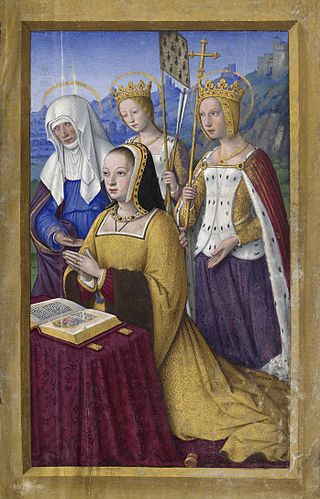
The Grandes Heures of Anne of Brittany is a book of hours, commissioned by Anne of Brittany, Queen of France to two kings in succession, and illuminated in Tours or perhaps Paris by Jean Bourdichon between 1503 and 1508. It has been described by John Harthan as "one of the most magnificent Books of Hours ever made", and is now in the Bibliothèque nationale de France catalogued as Ms lat. 9474. It has 49 full-page miniatures in a Renaissance style, and more than 300 pages have large borders illustrated with a careful depiction of, usually, a single species of plant.

The Hours of Mary of Burgundy is a book of hours, a form of devotional book for lay-people, completed in Flanders around 1477, and now in the National Library of Austria. It was probably commissioned for Mary, the ruler of the Burgundian Netherlands and then the wealthiest woman in Europe. No records survive as to its commission. The book contains 187 folios, each measuring 225 by 150 millimetres. It consists of the Roman Liturgy of the Hours, 24 calendar roundels, 20 full-page miniatures and 16 quarter-page format illustrations. Its production began c. 1470, and includes miniatures by several artists, of which the foremost was the unidentified but influential illuminator known as the Master of Mary of Burgundy, who provides the book with its most meticulously detailed illustrations and borders. Other miniatures, considered of an older tradition, were contributed by Simon Marmion, Willem Vrelant and Lieven van Lathem. The majority of the calligraphy is attributed to Nicolas Spierinc, with whom the Master collaborated on other works and who may also have provided a number of illustrations.

The Petites Heures of Jean de France, Duc de Berry is an illuminated book of hours commissioned by John, Duke of Berry between 1375 and 1385–90. It is known for its ornate miniature leaves and border decorations.
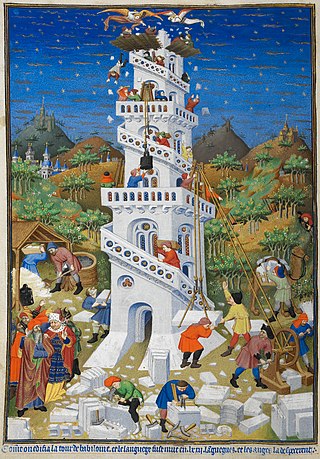
The Bedford Hours is a French late medieval book of hours. It dates to the early fifteenth century (c. 1410–30); some of its miniatures, including the portraits of the Duke and Duchess of Bedford, have been attributed to the Bedford Master and his workshop in Paris. The Duke and Duchess of Bedford gave the book to their nephew Henry VI in 1430. It is in the British Library, catalogued as Add MS 18850.

The Hours of Joanna I of Castile is a sixteenth-century illuminated codex housed in the British Library, London, under call number Add MS 35313.
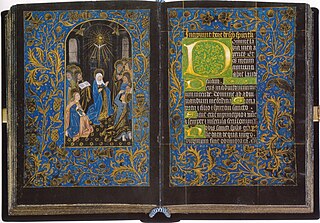
Black books of hours are a type of luxury Flemish illuminated manuscript books of hours using pages of vellum that were soaked with black dye or ink before they were lettered or illustrated, for an unusual and dramatic effect. The text is usually written with gold or silver ink. There are seven surviving examples, all dating from about 1455–1480.

The Pseudo-Jacquemart was an anonymous master illuminator active in Paris and Bourges between 1380 and 1415. He owed his name to his close collaboration with painter Jacquemart de Hesdin.

The Master of Margaret of York is the Notname of an illuminator active in Bruges between 1470 and 1480. He owes his name to a devotional book he decorated for Margaret of York, wife of Charles the Bold, Duke of Burgundy. A large number of his illuminated books were executed for Louis de Gruuthuse. Several manuscripts have also been attributed to his assistants.
